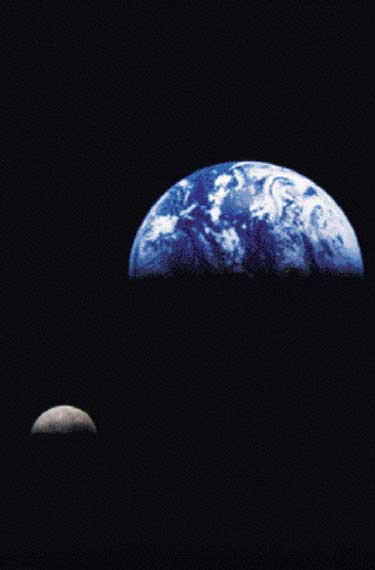 | A rare perspective, photographed by the Galileo spacecraft in December 1992, captures the close relationship of Earth and its only natural satellite. |
to 500 million times faster than the speed of light to pass stars so quickly. We doubt that Scotty could supply the necessary power from his warp engines on the Enterprise, even in his finest moments.
Other movies portray galaxies as swirls of light within which heroes and villains dash around at will, from one side to the other. To see how realistic that is, let's extend our basketball-Sun model to our galaxy as a whole. If the Milky Way's average stars were the size of basketballs, the galaxy would measure an astonishing 125 million miles across. That's an enormous volume in which to spread out 100 billion basketball-suns. Since it's also too big for most of us to grasp, we'll shrink the scale of our model much further. Imagine squeezing our entire solar system--planetary orbits and all--into a coffee cup. (The Sun would be the size of the tip of a pin in the center of the cup.) On that scale the Milky Way still would cover an area as large as North America.
To consider the distances between galaxies, let's take one more step and collapse the entire Milky Way into that coffee cup. The next nearest large galaxy--called Andromeda--then would hang in space about 7 feet away. Compared to the vast separations between individual stars, galaxies actually are fairly close neighbors in space. Surveys of chunks of the universe have revealed that galaxies are arrayed in clumps and spidery filaments, congregating around gaping voids that contain virtually no galaxies. Data suggest that these patterns trace the imprint of microscopic irregularities in the structure of space-time that arose during the first instants of the Big Bang.
Our series of earthly analogies may help your mind leap from one scale of the cosmos to the next. However, such descriptions do not capture the majesty of matter that inhabits these vast spaces. In that way, pictures truly are worth more than the words we use to describe them. Several images from recent decades have raised our awareness of our place in the cosmos. One such picture came from the Galileo spacecraft. On its way to Jupiter, Galileo looked back from beyond the Moon at the EarthMoon system. The fragile blue crystal of Earth and the familiar crescent of the Moon formed a cozy pair in space. The small gap between them made it clear (continued) |

